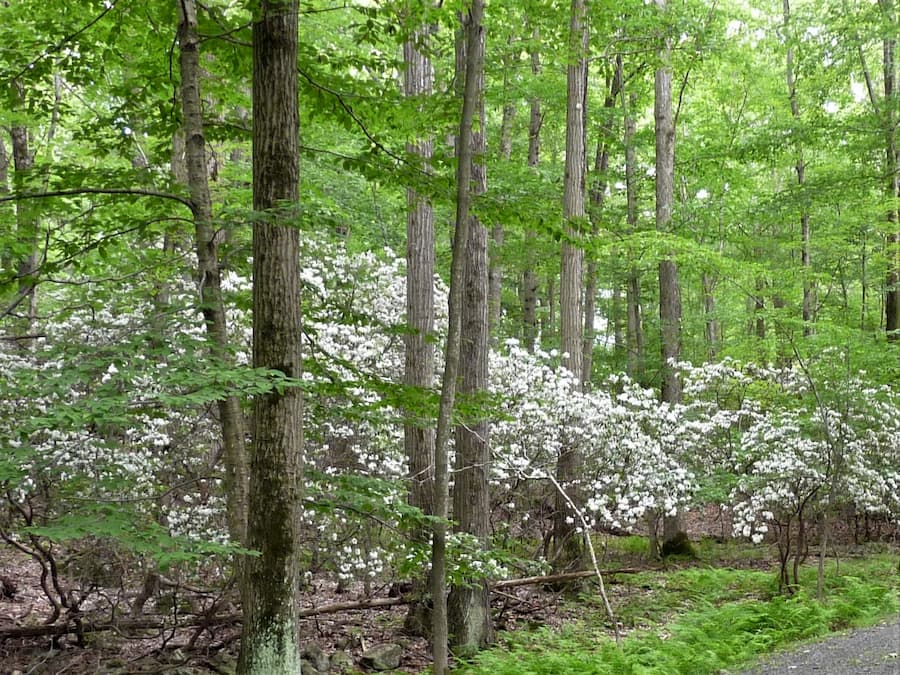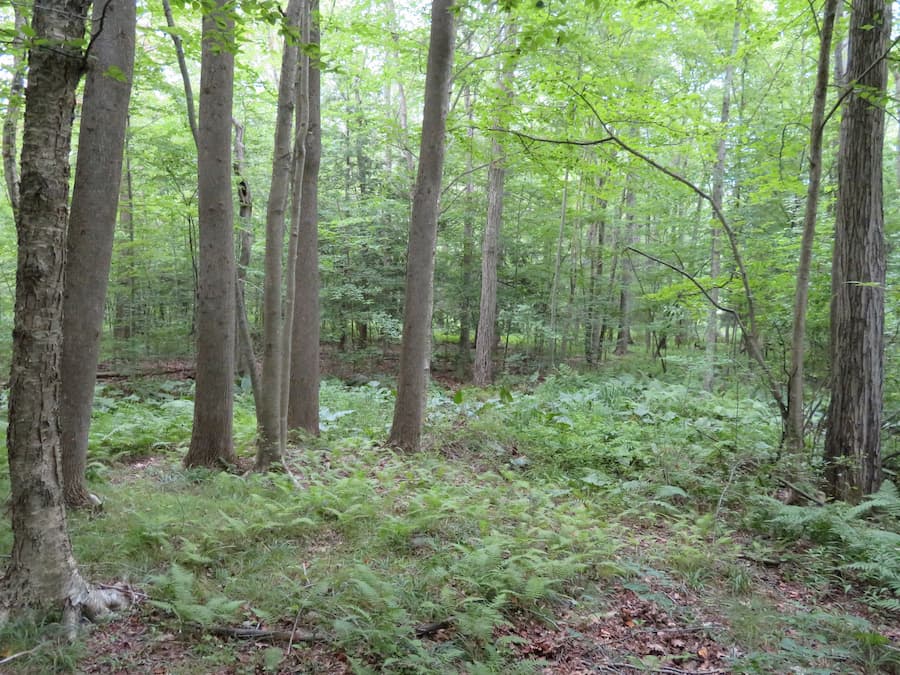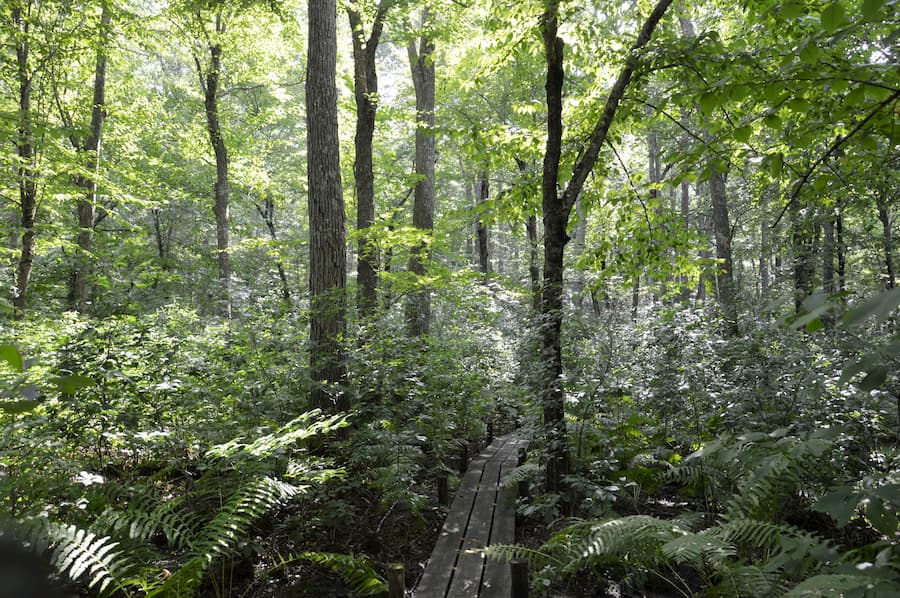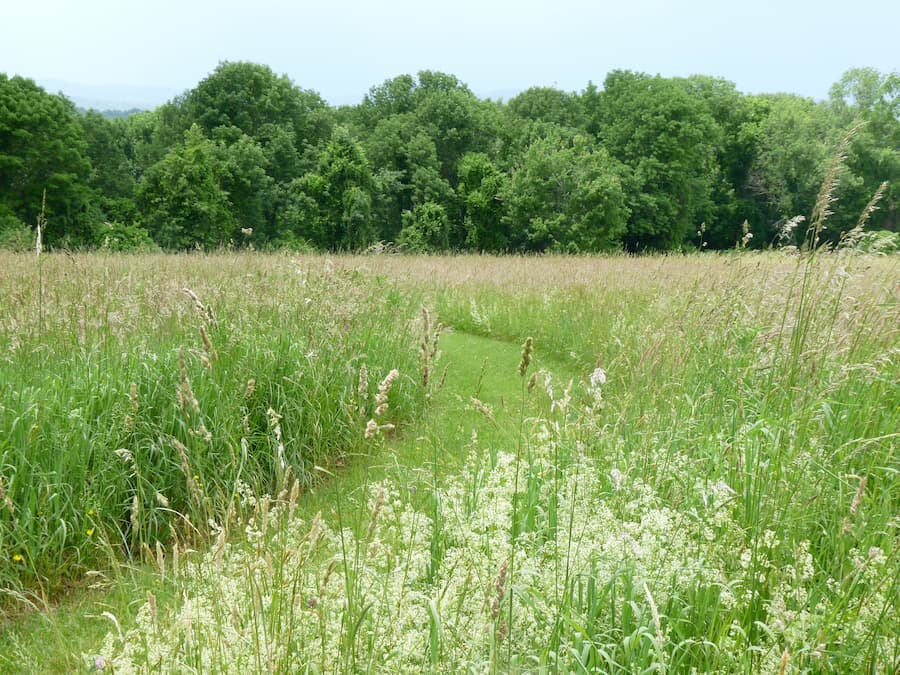Highstead’s woodlands and meadows provide beauty, cultural heritage, habitat diversity, and research opportunities. Meadows make up almost one-third of Highstead’s land, while woodlands comprise the other two thirds.
Woodlands
Oak-mountain laurel forest

Rocky ledges and dry, acidic soils on the western half of the property support 100+ year-old oak forests with towering mountain laurel understories. Chestnut oak and scarlet oak are the dominant trees on the ridgetop and upper slopes with huckleberry and Pennsylvania sedge appearing in the sparse understory beneath the laurel. On the moister lower slopes, red oak predominates with witch hazel joining mountain laurel in the understory and a more diverse herb cover, including ferns, appearing on the forest floor. White-tailed deer, wild turkeys, and red-backed salamanders are common inhabitants of this community type. Recent natural disturbances including wind and ice storms, and a history of gypsy moth outbreaks, have added to the structural complexity of this forest.
Mesic hardwoods

A small section of mesic hardwood forest with abundant fern cover occurs on the rocky, moist soils west of Tannery Brook adjacent to the Redding Country Club. Hickories, tulip tree, red maple, and oaks are common in the overstory, with ironwood and birch in the understory, and the shrubs a mix of spicebush and mountain laurel. This community type is transitional between oak-mountain laurel and red maple swamp.
Red maple swamp

High water tables and seasonally saturated soils in the basin and stream-side areas of Highstead support red maple-yellow birch-green ash forests. Fragrant spicebush and sweet pepperbush shrubs combine with dense herbaceous layers of skunk cabbage and cinnamon fern to provide the characteristic lushness of this community. Among other animals, box turtles inhabit this community type. Many of the green ash (Fraxinus pennsylvanica) have been weakened or killed by the arrival of the emerald ash borer, an exotic insect.
Red maple-white ash forest

Moist, fine-grained soils of the drumlin’s lower slopes support red maple-white ash-tulip tree forests with spiny, exotic shrub layers and grassy herbaceous layers. These forests were historically cleared for agriculture and are consequently heavily invaded by invasive plants, including Japanese barberry, oriental bittersweet, multiflora rose, and Japanese stilt grass (Microstegium vimineum). White-tailed deer and red fox are common inhabitants of these woodlands. Emerald Ash Borer (EAB) has weakened or killed many of the white ash trees that were previously compromised by the ash decline complex. EAB, along with damage from recent windstorms, decades of deer browsing, and thick, exotic shrub layers have created and maintained large gaps in the canopy, providing habitat for disturbance-adapted species such as blue-winged warblers and the globally threatened New England Cottontail. Both of these species thrive in shrubby habitats with reduced tree canopy cover.
Meadows
The hilltop meadows

Meadows dominate the Eastern third of the property, covering most of the hilltop drumlin (about 40 acres in total). Introduced European grasses — timothy, smooth brome, orchard, and bent – are the dominant plant species with patches of the native forbs, Indian hemp, common milkweed, and the rare purple milkweed. Highstead maintains the meadows for their scenic beauty, cultural heritage, and as habitat for grassland species such as bobolinks and purple milkweed. Bobolinks migrate approximately 6,000 miles each year to nest in New England meadows. We mow the meadows once annually, in late-summer to ensure that young birds have fledged before the grass is cropped back. Bobolinks and other birds are monitored annually by local volunteers.
The Barn meadow

A two-acre meadow at the Highstead Barn was created during construction of an adjacent pond. Initially planted with a mix of grass and clover to prevent erosion, one-half was subsequently seeded with North American native prairie grasses and forbs for demonstration. Several management regimes were applied, and after nine years, the seeded half yielded twice as many native wildflowers and grasses and was less prone to invasive species colonization than the unseeded area.
Today, the Barn Meadow is maintained as habitat for songbirds, butterflies, and other pollinating insects that depend on wildflower meadows for habitat. It is mowed annually to prevent transitioning to forest.